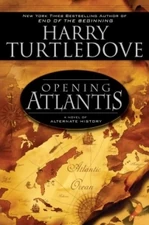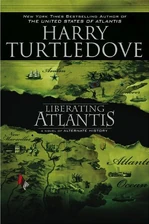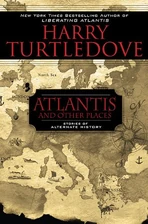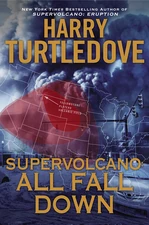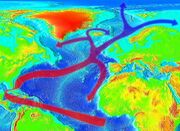
Gulf Stream on East coast of North America, then crossing the Atlantic Ocean to Europe and Africa.
The Gulf Stream, together with its northern extension toward Europe, the North Atlantic Drift, is a powerful, warm, and swift Atlantic ocean current that originates at the tip of Florida, and follows the eastern coastlines of the United States and Newfoundland before crossing the Atlantic Ocean. The process of western intensification causes the Gulf Stream to be a northward accelerating current off the east coast of North America. At about 40°0′N 30°0′W it splits in two, with the northern stream crossing to northern Europe and the southern stream recirculating off West Africa.
The Gulf Stream influences the climate of the east coast of North America from Florida to Newfoundland, and the west coast of Europe. Although there has been recent debate, there is consensus that the climate of Western Europe and Northern Europe is warmer than it would otherwise be due to the North Atlantic drift, one of the branches from the tail of the Gulf Stream.
Gulf Stream in Atlantis[]
The Bay Stream was a warm ocean current originating in the Bay of Mexico and flowing northeast through the Hesperian Gulf and the North Atlantic to Europe. It had a greatly warming and moderating effect on Atlantis' west coast making it more temperate and wet than the east coast. For instance, New Marseille basked in an almost unending May while Avalon, further north, lived in a perpetual April.[1]
Gulf Stream in Supervolcano[]
Rob Ferguson had heard that the Gulf Stream was in trouble since the Yellowstone Supervolcano eruption. This had caused the Gulf of Mexico and the Caribbean to be much cooler and, in turn, led to less warm water going out into the Atlantic which would make northwestern Europe much colder. Ferguson wondered if it would cause Europe to be covered by a wall of ice.[2]
Over the next few years, this seemed to come to pass as the winters in Britain became harsher and harsher. It was often remarked that the U.K. was on the same latitude as Labrador and the weather began to match.[3]
References[]
- ↑ "Audubon in Atlantis", page 17, Atlantis and Other Places
- ↑ All Fall Down, pgs. 189-190, HC.
- ↑ Things Fall Apart, pg. 343, HC.
| ||||||||||||||||||||||||||||
| |||||||||||||
